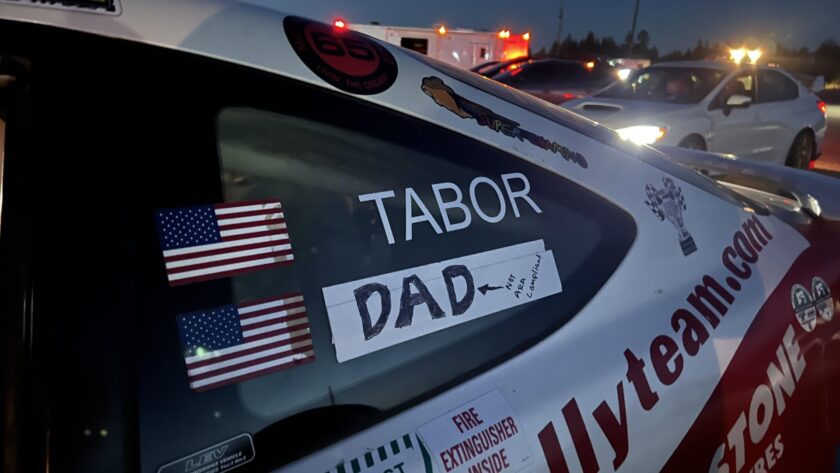
According to Robin Miller’s article, the non-disclosure agreement that he was under has just expired, but his article still did not provide a picture of this new IndyCar concept, but it did add quite a bit to our understanding of what this cars design goals are.
The car’s chief designer is Ben Bowlby, who happens to be the current chief engineer for Target Chip Ganassi and former lead designer for Lola. Clearly, this guy has the credentials to back up his design effort, though one would have to question what kind of advantage this would give TCGR if the car were accepted. One also would have to ponder why Penske was denied their request to make their own chassis back when Dalarra, Panoz & Falcon were approved as IRL chassis manufacturers. I guess a lot has changed since then.
 Ben is not in this alone. A company has been formed called Delta Wing LLC and is jointly owned by team owners Michael Andretti (Andretti Autosport), Eric Bachelart (Conquest), John Barnes (Panther), Tony George (Vision), Kevin Kalkhoven (KV), Roger Penske (Penske), Dennis Reinbold (Dreyer & Reinbold), Keith Wiggins (HVM) and Chip Ganassi (TCGR). The name of the company alone makes us wonder what this car will look like, since the delta wing style of jet fighter with wheels would not make the most attractive race car.
Ben is not in this alone. A company has been formed called Delta Wing LLC and is jointly owned by team owners Michael Andretti (Andretti Autosport), Eric Bachelart (Conquest), John Barnes (Panther), Tony George (Vision), Kevin Kalkhoven (KV), Roger Penske (Penske), Dennis Reinbold (Dreyer & Reinbold), Keith Wiggins (HVM) and Chip Ganassi (TCGR). The name of the company alone makes us wonder what this car will look like, since the delta wing style of jet fighter with wheels would not make the most attractive race car.
The chassis itself reportedly has no front or rear wings. Instead it will rely upon under car airflow to provide downforce. Ahh, the return of ground effects. No wooden FIA legality plank here.
Also, the chassis is going to be ultralight. No word on what that means in comparison to the current weight, but the current IndyCar weighs in at 1525 lbs on ovals and 1600 lbs. on road courses (without driver). For comparison, a 2009 F1 chassis weighed in at a minimum of 1334 lbs with driver.
The engine will be a non-stressed engine. The current Honda IndyCar engine is a stressed member of the overall Dalarra chassis. The current engine and gearbox support the rear assembly of the car including suspension, half shafts, rear wheels and rear wing. A non-stressed engine would be something like the engine in your car. It is bolted to the frame, but does not make up part of the frame.
Also, the engine is going to be a 4 cylinder, turbocharged package. This would allow different boost settings to be applied for different tracks (i.e. more boost for road courses, less boost for ovals) so that the overall power output of the engine can be matched to the top speeds that the series wants to see at any given venue. Along with the ultralight nature of the chassis, the overall fuel efficiency would be something around 10 miles per gallon, which would allow you to run the Indy 500 on 50 gallons of fuel. Obviously, this would be different on road and street courses since they are much more ‘city’ driving compared to the ‘highway’ driving on the ovals.
Take the overall changes to the engine package (smaller engine, non-stressed, lighter car) and the hope is that the engine could be produced for around $140,000 per.
Another benefit of the chassis design is that their would be increased surface area for sponsor logos. Whatever the case, the car has been described as a cross between a motorcycle and a sportscar (Le Mans style), it has also been described as a futuristic jet fighter on wheels. Whatever the case, it supposedly was at one point during design a 3-wheeled chassis, but the FIA nixed that idea saying that 4 wheels makes a car.
According to Robin Miller’s article, this would supposedly bring innovation back to IndyCar racing, but it is unclear what that actually means. The design of the chassis certainly sounds innovative, but will the teams be allowed to independently develop their own chassis? Will engine development be allowed?
Delta Wing LLC sounds like they don’t want to manufacture the parts for the car, they want to outsource. Most likely that means Dalarra would still be on board, but possibly a Panoz or Swift might get involved. The Indianapolis Business Journal says that the car most likely would be made in Indianapolis, but I see nothing currently that supports that idea. Obviously, the IRL has to green light this chassis as the 2012 IndyCar before many of these type of plans can be finalized.
If this chassis gets the go ahead from the IRL, then we might start seeing pictures of the car. Further, a rolling prototype chassis could be on the track by June or July for testing. This puts the kaibash on rumors that they already had a rolling chassis being tested in TCGR’s secret underground tunnel.
My thoughts:
If you are just coming out with a new spec chassis, then I don’t fully understand why you would go away from the traditional winged IndyCar appearance. The current style of car was an evolution of years of development, and without simultaneously developed solutions from others, it is not clear that this actually would perform better than an ultralightified version of the Dallara chassis with a similar engine in it.
That said, this chassis appeals to me on several fronts. More add space on the cars would certainly help the league and the teams. A lighter car would allow for better fuel efficiency which is a goal of the series. Underbody ground effects would certainly be a safer option than externally mounted wings. We have all seen the calamitous impacts caused by rear wing failure. The cheaper engine package would help the economics of the teams.
What I am afraid of though is my reaction to finally seeing a picture of this car. If it looks ridiculous, then all the achieved design goals may not make up for a perceived lack of visual appeal. Of course, all of the iterations that brought us from upright front-engined roadsters to our current design have all met with some resistance, but in all of those circumstances, performance on the track silenced the critics. Without nothing to compare this new design to, this may be the jumping off point of many of the oldtimers. We shall see.




The more I think about this new design, the more I’m liking it. …with the caveat that we have extremely little data at the moment. I do see this as both a revolution and an evolution. Lifting-body aerodynamics are the natural evolution of winged designs, and it could achieve a number of goals simultaneously: cost reduction, improved sponsor visibility, improved safety, improved fuel efficiency, and improved perception of the IZOD IndyCar Series as a technological leader.
I’d also like to see this design be able to accommodate more than a single engine spec. We know that Honda HPD would prefer a V6 engine, while VW/Audi and Fiat would rather see an I4. I think there’s room for both with clever and careful construction of the technical regulations and proper scrutineering. It was already stated that these chassis wouldn’t be a simple bolt-n-go kit that must not be alters, but that engineers would have a certain degree of freedom to develop and improve the chassis over time. This is something that both fans and teams have been after for a LONG time. Lastly, this chassis will be a real winner if it is allowed to run at near record speeds at IMS.
I like what they are saying so far I would like to see many engines, limited by displacement say 2.0 Liter with a non streesed chassis it would leave to open to many configurations and induction types that could be very competitive, 4’s, v6, v8, rotory, whatever can make a Indy Car lap at 200mph and get some kind of milege… I know there are many power plants out there could do it based on 2.0 liters and unlimited induction…..I know what a lot of people will say to unlimited induction but remember a lot of types would be in the catagory of the number one enemy of Race car Weight!!!!!!! And not advantagous. Chris
Ps. You Gotta Agree= 4 wheels makes Car!!!!
Yeah Chris, a 3-wheel concept was not going to fly with anybody, even if it was somebody in 1983’s idea of the future.
On the engines, it is certainly intriguing to think about the possibilities that a non-stressed engine allows. It would certainly be cheaper for an engine manufacturer to convert their powerplant over to work with IndyCar if it does not have to serve as part of rear frame and crash structure.
But it all goes down to looks right now. I like the design goals of this new chassis, but if it looks like a turd on (4) wheels, then it may take some slick marketing to get people to watch.
I attached one of the pictures from the college design program and have to admit this was probably my favorite of all the concepts that came out of it. I could do without the roof and the captain america shields on the sides, but overall that is a pretty slick looking car.
Is sounds like this is going to be a new spec car. If that’s the case, I’m going to be disappointed. I would like it if they had a handful of new chassis and engines, all with different design concepts, and see which is the best one on the track. I understand that there are cost considerations but what’s the difference between having 33 Dallara/Honda’s in the Indy 500 and 33 of whatever this car is going to be?
I like that they are trying to bring back innovation, but this top-down innovation seems contrived. Rear engines, wings, turbochargers, and ground effects came to Indy when teams developed the cars and entered them in the race. They did that becasue they wanted the best car so they could win. This bottom-up innovation added a lot of presitge to the race – people came from all over the world and developed cars specifically to win the Indy 500. I think that presige is lost if if is reduced to a spec race.
I know that the IRL is trying to survive during a very difficult time. Hopefully the series will get stronger and attract enough interest and money that teams, car builders, and engine designers are able to start to invest in designing and building their own technology again.
I agree with you Henry, this “contrived top down innovation” could backfire. If the viewing public thinks that the new car looks silly and was purely a contrived car, then there could be a backlash from what fanbase the IRL has left.
But as Chris alluded to, this could be a first step in bringing some level of innovation back. With the non-stressed engine package, they could more easily adopt ALMS style engine equivalency formulas on the fly to allow manufacturers to more easily adapt their engines for other racing series to work in IndyCar.
Since Delta Wing LLC states that they dont want to be a manufacturer, prefering to outsource. Maybe this could mean outsourcing the safety cell and crash structure to the package and then allowing the teams to develop the rest to their own tastes. Probably not though. Even though this would be a great way to open things up again, in this current economic environment and given IndyCar’s current stature, it will most likely be business as usual, just with a funky new chassis.
Still, we can hope.
[…] The car’s chief designer is … Details & Picture […]
Agree with all the comments on this topic. Top down never really works well….but I think that if they just set the standard and then let the manufacturers build on the intro engine, more brands may come in. It will be interesting, but we need this to actually happen. While redesigning the car, we must make it to where the brands want in…really tough thing the IRL is trying to accomplish.
“Since Delta Wing LLC states that they dont want to be a manufacturer, prefering to outsource. Maybe this could mean outsourcing the safety cell and crash structure to the package and then allowing the teams to develop the rest to their own tastes.” -Mike
This is exactly what I’ve been getting from what little has leaked out. There would be a base platform and safety cell, but various manufacturers such as Swift, Panoz, and Dallara would be welcome to manufacturer their own parts to fit onto the base chassis. If this is the case, then I’m all for it. Isn’t this what we’ve been asking for anyway? A standardized tub, some modest constraints, and leave the rest up to the teams and private manufacturers?
The cars haven’t needed wings in years, the only reason the have them is because the rules limit undertray depth and profile. CART banned single arch cars right when ground effect cars started showing up athe speedway, the IRL has always had a limit on undertray and have always specified a twin arch design. F1 had teams try to enter wingless cars (lotus88, arrows a2) that either got banned or didn’t work. But a variable geometry, multi contured undertray covered in the right body could provide useable, SLIDEABLE, driveable downforce at high and low speed. A wingless car can slingshot draft and run side by side, so if built right it should put on good races, I hope they buid it!
eh… i think everyone likes the turbocharged engines coming back, but i personally dont really want to see the IICS chassis to look like a car from the new Speed Racer movie. Yes, the picture at the top and the picture drawn by the article sound intriguing, but i absolutely love the open wheel style chassis that has taken over the REAL racing world since the 70s. my best case scenario would be turbocharged engines manufactured by a handful of household engine names(i.e. porsche, audi, alfa romeo, toyota, maybe bmw, and honda among others) and a chassis similar to a champcar chassis, whether that is the panoz dp01 that was okay, or something like pre dp01, which i believe almost everyone loved. it will no doubt be exciting as we are given more info, but i for one, dont want to see indycars looking like a spacepod for the first star wars episode, but more like the chassis of late 90s and 2000s that we all loved